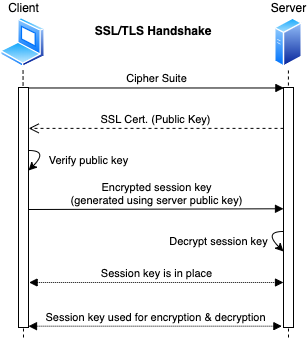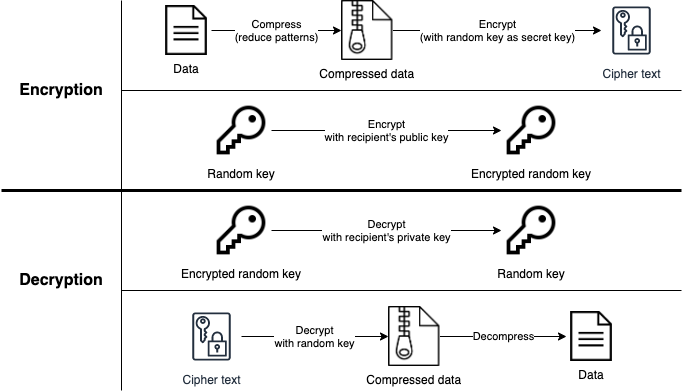Encrypting communication
- Can happen in different layers on Internet protocol suite e.g.
- Link layer: • [PPP]
- Internet layer: • IPSec
- Transport layer: • TCP
- Application layer: • SSH • FTP, SFTP, FTPS • SSL / TLS
SSL/TLS
SSL (Secure Sockets Layer)
- Protocol on the application layer
- Created to ensure the security of the message transmission over the network and Internet.
- ❗ Not secure and has known vulnerabilities, use > TLS 1.2 instead.
- 📝 Uses both asymmetric and symmetric authentication mechanisms
- Asymmetric encryption is used to establish a secure session between a client and a server
- Utilizing RSA and digital certificates
- Symmetric encryption is used to exchange data within the secured session
- Asymmetric encryption is used to establish a secure session between a client and a server
- Encrypts data at Transport Layer of TCP/IP stack and above
TLS (Transport Layer Security)
- 📝 More secure successor of SSL
- Protocol to establish secure client-server connection.
- Ensures the information integrity and privacy during transmission.
- Uses RSA 1024 and 2048 bits
- ❗ Use at least TLS 1.2, lower version has vulnerabilities.
- Most commonly used implementation of SSL/TLS is OpenSSL library.
- Vulnerabilities include • Heartbleed (OpenSSL) • POODLE • CRIME and BREACH • Renegotiation attack • FREAK • DROWN
Two layers of TLS
- TLS Record Protocol
- Provides secured communication channel
- Private connection: using symmetric cryptography for data encryption
- Reliable connection: providing message integrity check
- TLS Handshake Protocol
- Providing connection security that has three basic properties:
- The peer's identity can be authenticated using asymmetric cryptography
- The negotiation of a shared secret is secure
- The negotiation is reliable
- TLS Handshake Protocol operates on top of TLS record layer
- Providing connection security that has three basic properties:
SSL/TLS Handshake

Securing FTP
Insecure FTP options
FTP (File Transfer Protocol)
- Used for the transfer of computer files between a client and server on a computer network.
- Runs on Application layer (4) in internet protocol suite
- Insecure as it has minimal security through user ID and passwords.
- Runs on port 21
TFTP (Trivial File Transfer Protocol)
- Less secure than FTP using no authentication at all
- Runs on port 69
Secure options
Encrypting files before using FTP
- Does not protect user password, or prevent man in the middle from downloading encrypted files
SFTP (SSH File Transfer Program) | port: 22
- Uses SSH for authentication and data transport mechanism
FTP over SSH
- SSH connection must be established between the two systems before the FTP connection is established
FTP over IPSec
- IPSec runs on lower layer Internet layer (3) on IP suite.
- Can cause high amount of CPU cycles on interrupt or kernel level.
FTP over VPN
FTP over TLS
- Also known as • FTPS • FTP-SSL (old name) • FTP Secure
Comparison
Method Password Privacy Server Verification Data Privacy Data Integrity Test and Binary Transfers Automatic Separate encryption No No Yes Maybe Maybe No, file must be encrypted and decrypted separated from the transfer SFTP Yes Yes, private key Yes Yes Maybe Yes FTP over SSH Yes Yes, private key Yes Yes Yes No, separate setup of the tunnel is needed FTP over IPSec Yes Yes, private key or certificate authority Yes Yes Yes Yes, but configuration can be a challenge FTP over VPN Yes Maybe Yes Yes Yes Maybe, but may have configuration challenges FTPS Yes Yes, private key or certificate authority Yes Yes Yes No, but it's easy to use
Digital signatures
- Created using asymmetric cryptography
- Attached to the transmitted data
- 📝 Usually used in cases where it is important to detect forgery or tampering
- E.g. • software distribution • financial transactions • contract management software
- 📝 Provides cryptographic way of
- Authentication
- Verifies identity of the source messages
- Through a secret-key that's bound to a specific user
- Integrity
- Ensures the communication is not altered during transmission
- Avoids forging as any change would invalidate the signature
- Non-repudiation of origin
- The sender cannot falsely claim that they have not signed the message
- Authentication
- ❗ Risks
- Revoked secret key (key pair) prior to its usage
- Leaked secret keys that would continue to implicate the claimed owner of the key-pair
- 📝 Simplified flow
- Sender hashes the file and encrypts using sender's private key
- Provides non-repudiation since only the sender has access to their private key.
- However there's no confidentiality as it can be unencrypted by anyone with access to the sender's public key
- The hashing of the email is what creates the integrity.
- Recipient decrypts the message with its sender's public key
- Sender hashes the file and encrypts using sender's private key
- Digital Signature Algorithm (DSA) is the standard used in generation and verification
Encryption vs Signing
- When encrypting:
- You use their public key to write a message
- They use their private key to read it
I want my public key to be used to read the messages and I do not care who reads them
- When signing:
- You use your private key to write message's signature
- They use your public key to check if it's really yours.
I only care that I am the only one who can generate these.
Digital signature flow

Public Key Infrastructure (PKI)
- Security architecture/structure for managing digital certificates
- 📝 Goal is secure electronic transfer of information for a range of network activities
- Provides confidentiality, integrity, access control, authentication, and non-repudiation of the sender.
- Includes hardware, software, people, policies, and procedures
- Goal is to increase the confidentiality of information that is being exchanged.
- Used widely e.g. by browser, operating systems for system updates...
- Cross-Certification
- Allowing a CA to trust another CS in a completely different PKI
- Allowing both CAs to validate certificates from either side
- Single-authority system
- CA at the top that creates and issues certificates
- Hierarchical trust system
- CA at the top (root CA)
- Making use of one or more RAs (subordinate CAs) underneath it to issue and manage certificates
Key escrow
- Also known as fair cryptosystem
- Allows a third party to access sensitive data if the need arises.
- A copy of a private key is stored to provide third-party access and to e.g.
- facilitate recovery operations
- comply with a court order
Actors of PKI
- Validation authority (VA)
- 📝 Used to validate certificates, stores certificates with their public keys
- Certificate authority (CA)
- Also known as certification authority
- 📝 Third party to issue and verify digital certificates
- Digital certificates contain public key and the identity of the owner.
- E.g. Comodo, IdentTrust, GoDaddy
- Registration authority (RA)
- 📝 Acts as verifier for the certificate authority
- Certificate Management System
- Generates, distributes, stores, and verifies certificates
- End user
- Requests, manages, and uses certificates
PKI process flow
- A user applies for a certificate with his public key at a Registration Authority (RA)
- Registration Authority (RA) confirms the user's identity to Certificate Authority (CA) which in turn issues the certificate and informs Validation Authority (VA)
- The user can then digitally sign a contract using his new certificate.
- His identity is then checked by the contracting party with a Validation Authority (VA) which again receives information about issued certificates by the Certificate Authority (CA).

Digital certificate
- Electronic file
- Used to verify a user's identity (= non-repudiation)
X.509
- Standard protocol used for digital certificates, public key encryption
- Defining all sorts of things regarding PKI including digital certificates
- Identifies components of a digital certificate: • version • algorithm ID • copy of the public key • key usage description
Digital certificate vs digital signature
- The certificate ties the digital signature to a data object.
- Digital signature secures the data in transit.
- Digital certificate uses the public key to identify source of the data.
- the digital signature uses the public key to verify integrity of the data.
- ❗ Signatures do not help with revoked keys and stolen keys
- CA maintains certificate revocation list
- Certificates helps to prove senders authenticity of public keys (e.g. who signed what)
- Sender obtains digital certificate by registering his public key to a certificate authority.
- CA uses its private key to sign senders certificate and attaches CA public key to his certificate.
- Receiver decrypts and validates signature using certificate authority's public key.
Certificate types
- Signed certificate
- Issued by Certification Authorities (CA)
- Contains a public key and the owner's identity.
- Self-signed certificate
- Issued and signed by oneself (not CA)
- ❗ Not to be trusted
- Used for testing/development purposes
- Otherwise better to use let's encrypt that offers free SSL/TLS certificates
PGP (Pretty Good Privacy)
- Encryption program
- Protocol for
- secure communication through encryption and decryption
- authentication (ensures users are who they claim to be)
- Uses a serial combination of
- hashing
- data compression
- symmetric-key cryptography
- public-key cryptography
- Main uses include
- Sending and receiving encrypted emails.
- Verifying the identity of the person who has sent you this message
- Encrypting files
- Available as both open-source and commercial software
Web of trust
- Used by PGP
- Decentralized model
- Individual users sign keys that belong to other people
- Validates that key are who they say they are
PGP encryption and decryption workflow

PGP tools
GNU Privacy Guard
- Also known as GnuPG or GPG
- Open-source and free implementation of PGP
- Allows to encrypt and data and communications
- E.g. create key pair
gpg --gen-key - E.g. for symmetric encryption only
gpg -c <file-name>to encryptgpg <file-name>to decrypt
PGP Alternatives
PEM (Privacy-Enhanced Mail)
- Proposed IETF standard for secure email, obsoleted by PGP.
- Depended on a single root certificate for its public key infrastructure (PKI)
- Was impractical and had its own problematic implications for security.
S/MIME
- Secure/Multipurpose Internet Mail Extensions
- Standard for encrypting and authenticating MIME data
- Used primarily for Internet e-mail.
- PGP is an application, whereas S/MIME is a protocol.
- PGP can be used to encrypt not only e-mail messages but also files and entire drives.